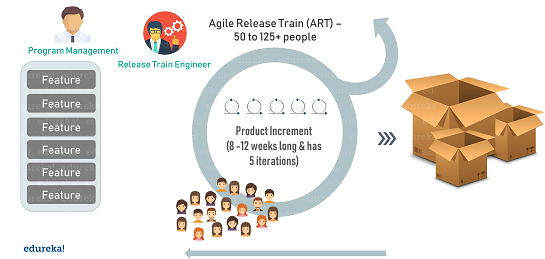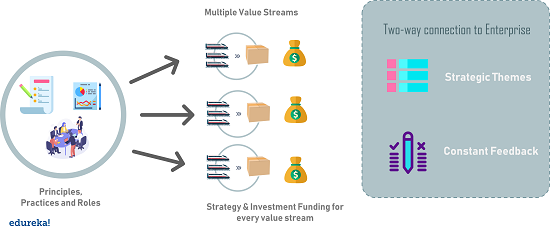PMP Certification Training
- 87k Enrolled Learners
- Weekend/Weekday
- Live Class
A lot of organizations are making a transition from traditional waterfall methodology to agile practices. Yet, a common complaint is that agile development doesn’t scale well. There are a number of agile frameworks that are now available for large-scale enterprise projects. This article focuses on one of the most popular large-scale agile frameworks: Scaled Agile Framework (SAFe). Let’s dive deeper into what exactly Scaled Agile Framework is and how it is typically implemented.
Currently, Agile is a well-known development concept and the approach of choice for many development teams, especially those trying to create an environment of continuous delivery. Though everyone is going agile these days, a common complaint is that it doesn’t show satisfactory results at the enterprise level. It poses a lot of issues like:
There is a lot of scaling agile frameworks that look to solve the problems associated with agility at scale. The three leading frameworks are Large-Scale Scrum (LeSS), Scaled Agile Framework (SAFe) and Disciplined Agile (DAD). In this article, our main focus is on the Scaled Agile Framework.
Scaled Agile Framework, also known as SAFe, is an enterprise-scale development framework, developed by methodologist Dean Leffingwell. It uses a combination of existing lean and agile principles and combines them into a templated framework for large-scale projects.
SAFe was developed in the year 2011 to help software development teams bring better quality products to market at a faster pace. It focuses on four fundamental values, which are:
Alignment
It is necessary to keep up with rapid change, disruptive competitive forces, and geographically distributed teams. More importance should be given to enterprise business objectives over team goals.
Built-in Quality
It ensures that every element and every increment of the build are up to the same high standard of quality throughout the development lifecycle. Quality is very important, without it, the organization will likely operate with large batches of unverified, unvalidated work.
Transparency
Developing products in large scale is not an easy task. To achieve best results transparency within the organization is really important. Transparency & trust ensure that the business and development can confidently rely on another to act with integrity, particularly in times of difficulty.
Program Execution
Naturally, nothing matters if teams can’t execute and continuously deliver the best results. That is why SAFe places an intense focus on working systems and business outcomes. Though the transition to agile is common, often teams struggle to deliver more substantial amounts of solution value, reliably and efficiently.
The Scaled Agile Framework attempts to incorporate all these core values to bring substantial improvements to delivery time, employee engagement, work productivity and mainly, quality of the product. Now that you have an idea of what SAFe is, let’s dig a little deeper to know more.
SAFe is a template to scale agile to large organizations. It has four levels, which are:

Let’s learn more about each of these levels.
Note: Key SAFe Terms
At the team level, the techniques outlined are those used in the Scrum, delivering product increment (working software) every two-week sprint cycle. However, teams can also work in Kanban or Scrumban. The Team Level contains the roles, artifacts, events, and processes which agile teams build and deliver.

The SAFe team level is a vital part of the Program Level. But, what exactly is the program level?
At the program level, SAFe works the same as at team level, except at large scale. As in, it refers to multiple teams working together under the leadership of the program management team, and delivering value in the concept of Agile Release Train. It has program level teams, roles, and activities that deliver a continuous flow of value.

Step1: Product Manager determines the content of a potentially shippable increment by means of a Program Backlog
Step2: The product increment starts with Product Increment Planning (PI Planning), a cadence based, face-to-face planning, aligning all the teams on the ART to the mission.
Step3: Then the teams break up to discuss what they can do within their group while aligning with other teams. They basically plan and discuss a number of sprints ahead on the feature level, unlike scrum does (Scrum only plans one Sprint ahead).
Step4: The commitments of the teams and dependencies between teams are mapped on a program board.
Step5: Scrum Masters and Release Train Engineer, who is the chief Scrum Master for the train, facilitate programs through various mechanisms like program kanban, inspect & adapt workshops, etc. to discuss the progress of the mission. This completes four development iterations.
Step5: Next up is 5th iteration. It is for hardening, innovation, and planning. Hardening involves final verification and testing. Innovation is all about exploring new ideas. Planning entails maintenance on the release train and the planning for the next cycle of 10 weeks.
This level also has an architecture runway that consists of existing code, components, and technical infrastructure to support product features. Next up we have an optional level called Value Stream Level.
The Value Stream Level is an optional level intended for builders of large and complex solutions, that typically require multiple ARTs as well as the contribution of suppliers. It offers a number of features that are new in SAFe 4.0.
Note: Each value stream is a long-lived series of system definition, development, and deployment steps used to build and deploy systems that provide a continuous flow of value to the business or Customer.

Lastly, we have a portfolio level.
The Portfolio is the highest level of concern in SAFe. It provides the principles, practices, and roles needed to initiate, organize and govern a set of development value streams. Defines strategy and investment funding for the value streams and their solutions.

Each SAFe portfolio has a two-way connection to the enterprise.
This way Scaled Agile Framework acts as an interactive knowledge base for implementing agile practices at enterprise scale. It offers four flavors of SAFe configurations.
SAFe supports the full range of development environments with four various configurations,
The Essential SAFe configuration is at the heart of the framework and is the simplest starting point for implementing SAFe. It is the basic building block for all other SAFe configurations and describes the most critical elements that are required to make use of the majority of the framework’s benefit. Consists of Team level and Program Level of SAFe.
This configuration is for developing the largest and most complex solutions that typically require multiple Agile Release Trains (ART) and suppliers, but do not require portfolio-level considerations. Commonly used in industries like aerospace, defense, automotive, etc. Consists of Team level, Program level, and Large Solution Level. Solution level helps enterprises that face the biggest challenges—building large-scale, multidisciplinary software, hardware, and complex IT systems.
Portfolio configuration helps to align portfolio execution to enterprise strategy and provides the basic constructs for organizing the Lean-Agile Enterprise around the flow of value. Lean-Agile budgeting empowers decision-makers, kanban system provides portfolio visibility and WIP limits, enterprise architecture guides larger technology decisions. And objective metrics support governance and improvement. The flow of value is delivered via Epics. It consists of Team level, Program level, and Portfolio Level.
It is the most comprehensive version of the framework and consists of all the four levels of SAFe – Team level, Program level, Portfolio Level, and Value Stream Level. Full SAFe supports enterprises that build and maintain large integrated solutions, that require hundreds of people or more, and includes all levels of SAFe. At times, in largest enterprises, multiple instances of various SAFe configurations may be required to function and deliver the product.
In simple terms, the Scaled Agile Framework is designed not so much as a single framework, but as a broad knowledge base of proven best practices that teams have used to deliver successful software products. It has its own plus points and negative points.
Although SAFe brings many benefits to the table, it also comes with its own drawbacks.
Bottom line, SAFe is created to cater to large organizations with large solutions, particularly by making it possible for organizations of a certain size to take a more agile approach to software development. However, it’s clear that SAFe has several drawbacks, of which teams should be aware of and plan accordingly.
That’s it, folks!. With this, we have reached the end of the article. You might feel overwhelmed with the number of key terms used here. If yes, you can refer to this Scaled Agile Framework Glossary.
Make sure you are well versed with the Scrum terminology before you start using it.
Got a question for us? Please mention it in the comments section of this “What is Scrum?” article and we will get back to you as soon as possible.
 Thank you for registering Join Edureka Meetup community for 100+ Free Webinars each month JOIN MEETUP GROUP
Thank you for registering Join Edureka Meetup community for 100+ Free Webinars each month JOIN MEETUP GROUPedureka.co